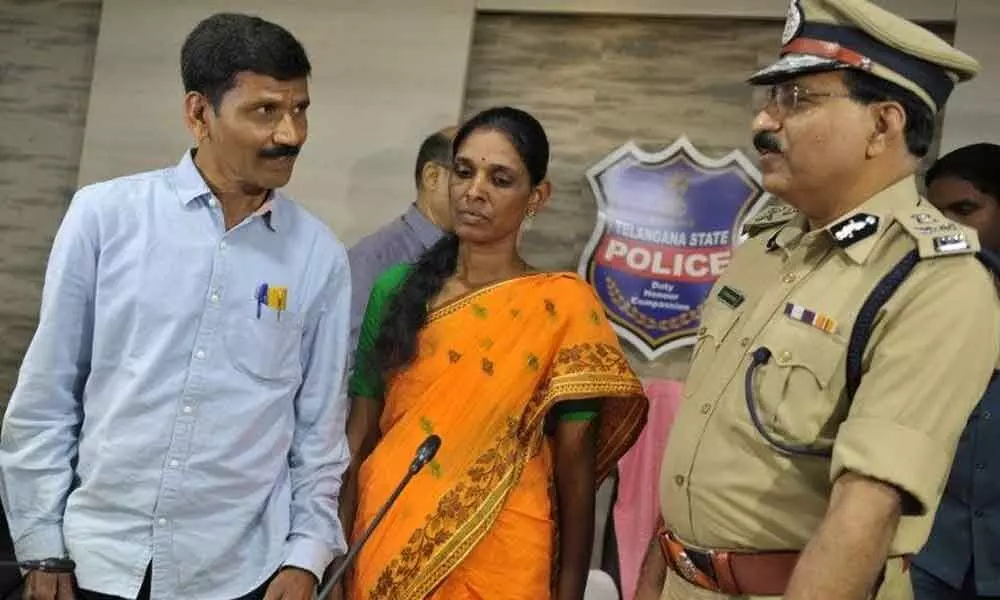Just In
Maoist surrenders on the rise as TS thrives


Maoist surrenders on the rise as TS thrives
It is an unprecedented event in the history of the erstwhile united state of Andhra Pradesh, that around 5 in the evening of October 1, 2003, People’s War Group activists triggered a series of nine powerful Claymore mines, which they are suspected to have planted over a period of time on the ghat road leading to Tirumala hills from Tirupati, barely minutes after the then Chief Minister's convoy had crossed Alipiri toll gate downhilll
It is an unprecedented event in the history of the erstwhile united state of Andhra Pradesh, that around 5 in the evening of October 1, 2003, People's War Group activists triggered a series of nine powerful Claymore mines, which they are suspected to have planted over a period of time on the ghat road leading to Tirumala hills from Tirupati, barely minutes after the then Chief Minister's convoy had crossed Alipiri toll gate downhilll.
The impact of the blast was so intense that Nara Chandrababu Naidu's bulletproof car was hurled into the air and landed on its side. Security personnel extricated the dazed and injured Chief Minister from the mangled car in which he was seated beside the driver. Those accompanying him were all injured and rushed to the hospitals. This was the second incident after the 1998 attack when PW cadres placed Claymore mines in a bullock cart alongside a road on which he was to travel during an Assembly by-election campaign in Karimnagar district and wherein a constable was injured.
PWG cadres were among the different groups of Naxalites. Communist Party of India (Marxist–Leninist) People's War, usually called People's War Group (PWG), was an underground Communist party in India. It merged with the Maoist Communist Centre of India to form the Communist Party of India (Maoist) in 2004, almost one year after the Alipiri attack.
Now, the difference between Maoist struggle and the Naxalite movement is that both trace their origin to the Naxalbari uprising of 1967. But while the Naxalite movement thrives on the original spirit of Naxalbari, the Maoist struggle is an outcome of the 1967 uprising. Maoists work with an agenda and use weapons to achieve their aims. Naxalism focuses on mass organisations, while Maoism relies mainly on arms. The underlying fact is that both are the two facets of the same coin.
The Maoist groups are the offshoot of Naxalism. And this is how the Maoist insurgency runs parallel to the history of Andhra Pradesh and Telangana. On Monday this week, 33 militia members of the banned Maoist party surrendered before Bhadradri Kothagudem Superintendent of Police in Telangana, bringing our attention back to these groups amid the Corona virus pandemic.
When we trace the time-line of Maoist surrenders in Telangana, interestingly we see that they started again in huge numbers since 2014. This is the case not just in Telangana but other States too. In August 2014, a Maoist couple of Chhattisgarh surrendered in Telangana. Then again in the following year in October, two Maoist cadres, including an outlawed CPI Maoist area committee secretary, surrendered to Telangana police. In 2015, a senior leader of the Communist Party of India-Maoist (CPI-Maoist), who was the deputy commander of Mangi Dalam operating in Telangana State, surrendered due to ill health.
In December 2017, top Maoist leader Jampanna and his wife surrendered before Telangana Police following 'ideological differences' with CPI (Maoist). In October 2018, a Maoist couple looking for peaceful life surrendered in Hyderabad. In February 2019, top Maoists surrendered in Telangana, making startling revelations blaming the group for extortion. Lastly, coming to the hallmark year 2020, at different times, there have been surrenders of cadres of different Naxalite groups in the State.
When we closely vet the timeline, we notice one thing that the Maoists in all these years have chosen the second half of the calendar year, i.e July, August, September, October, November and December to Surrender. If one can ask then, this can be a good question to be asked to the Maoists as to why they choose the last half-year to surrender. Is there any pattern behind it? One more interesting thing to be noted is that the Naxals or Maoists have always been at 'war' against successive governments and threatened the top political functionaries many a times while on the other hand, their friendly hand towards KCR's Telangana is something that raises questions.
How their surrenders are a good sign for the State? Firstly, it boosts the image of the State police who get them to surrender. Then, if few members from a larger group surrender, then they may help to track the other members engaged in the game. The ideology of left-wing extremism may not win new cadres. If more number of insurgents join hands with the State and join the mainstream, then there can be faster development. There will also be a reduction in landmine blasts, burning of road rollers and other violent activities that hamper development in the countryside.

© 2024 Hyderabad Media House Limited/The Hans India. All rights reserved. Powered by hocalwire.com






